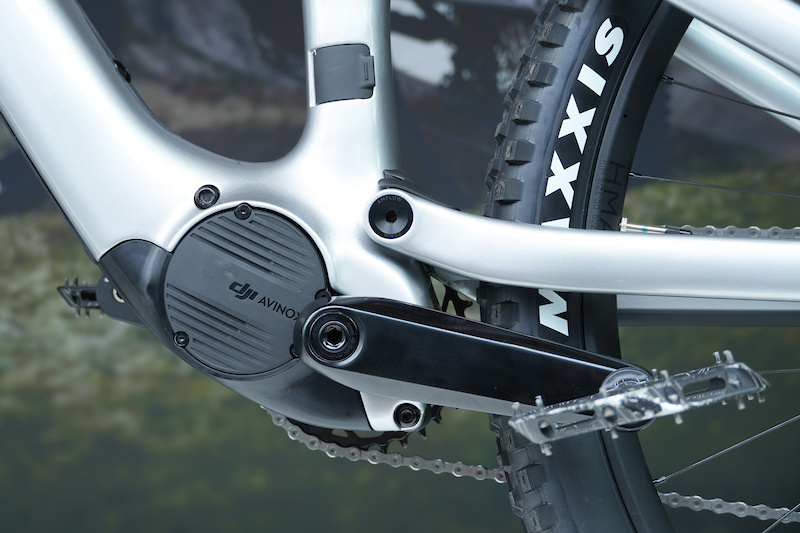Bussiness
2.52 kg DJI Avinox Motor with 120 Nm Torque Debuts on 19.2 kg eMTB – Eurobike 2024 – Pinkbike

DJI Avinox Motor System and Batteries
Motor technology is at the heart of DJI’s business. Thus it’s not completely wild for them to move into the production of eBike motors. What is wild is just how much torque and power they have been able to package into a drive unit that weighs just 2.52 kg, and one with such a small footprint, too (width of 137mm). To put that into context, the Shimano EP801 with 85 Nm torque and 600 W peak power weighs 2.7 kg. The Bosch Performance Line CX with the same outputs weighs 2.9 kg. The DJI Avinox manages to be lighter, smaller and more powerful than either of those.
Whether 120 Nm and 1000 W is needed on an eMTB is another matter entirely (and a topic for another time). More important here is that DJI are showing us what they are capable of. It’s very impressive, and i’m sure competing eBike motor manufacturers will be paying close attention, to say the least. Those numbers are accessed in Boost mode only, with the normal assistance modes offering a more modest 105 Nm torque and 850 W peak power.
I guess it comes as no real surprise that DJI are able to produce such a small, lightweight and powerful motor, given their history of producing very lightweight motors for drones for over 10 years. It is their bread and butter, so to speak. In contrast to the round shape that TQ’s concentric Harmonic Pin Ring drive unit permits, the DJI Avinox relies on compound planetary gears, giving it the more common oval shape. That gearing system that delivers the drive unit’s reduction steps is key to allowing the motor to be so compact overall.
DJI really are firing on all cylinders; their batteries are very lightweight, too.
They have made their own batteries to work with the Avinox, with cells produced by LG Electronics; there is a 600 Wh and an 800 Wh option. The 600 Wh battery weighs a claimed 2.78 kg – that compares to the Shimano 504 Wh battery that weighs 2.95 kg, and the 400 Wh PowerTube from Bosch that weighs 2.9 kg. The batteries are charged using GaN 3x Fast Charging technology. A compact charger can be used to charge the 600 Wh battery from 0% to 75% within 1.5 hours. The 800 Wh battery weighs a claimed 3.74 kg.
Amflow PL eMTB with DJI Avinox
The DJI Avinox finds its home on a 150mm travel eMTB with a 160mm fork. The Amflow PL is a full carbon affair with a four-bar linkage delivering that rear wheel travel. The top-end PL Carbon Pro model weighs a claimed 19.2 kg, as spec’d here. There is no launch date to speak of yet, though we were told the bikes will be available “some time this fall”.
The DJI Avinox is by far and away the most interesting feature of the Amflow PL – there is really nothing terribly notable about the bike itself. When it does come, it will be available in four sizes; M-XXL, with reach figures of 452mm, 475mm, 500mm and 525mm, respectively, with a 445mm rear-center. The head angle is 64.5° and the seat tube an effective 77°.
The top tube-mounted display is touch screen. You can swipe between screens to see different data sets about your ride; distance, support mode, speed, cadence etc., but also things like HR and calories if you connect it with a 3rd party HR monitor. As you can see, the display can also show you gradient; the DJI system has a pitch sensor, the data from which is fed into the DJI Smart-Assist Algorithm to help determine how much support the motor should deliver in the Auto mode.
Above the display is a USB-C charging port, to which you can connect your phone or bike computer to charge it as you ride. Underneath the display is a port for a sim card. That can be used to help locate the bike in the event it gets stolen, but it can also be used to directly upload data to Strava and other platforms.
There are five customizable assist modes; Auto, Eco, Trail, Turbo and Boost, and a Walk mode, too. A small wireless remote on the bar switches between the modes, but it isn’t essential. The ON button on the top tube display can also be used to switch between modes should you wish to keep the cockpit clutter-free.
I had a zoom about on the Amflow PL to get a quick impression of the motor. While it is impossible to say anything meaningful about the power delivery from such a short ride around on flat tarmac, I did pick up on an easily audible rattle from the clutch (something that almost every motor suffers from, a notable exception being the TQ-HPR50). The motor itself isn’t quiet, either, but I wouldn’t say it was any louder than the commonly available full-powered motors on the market.


)






